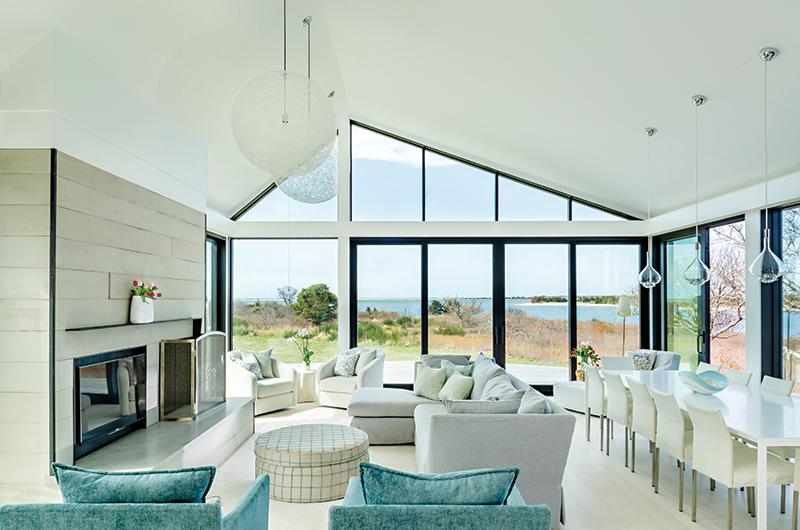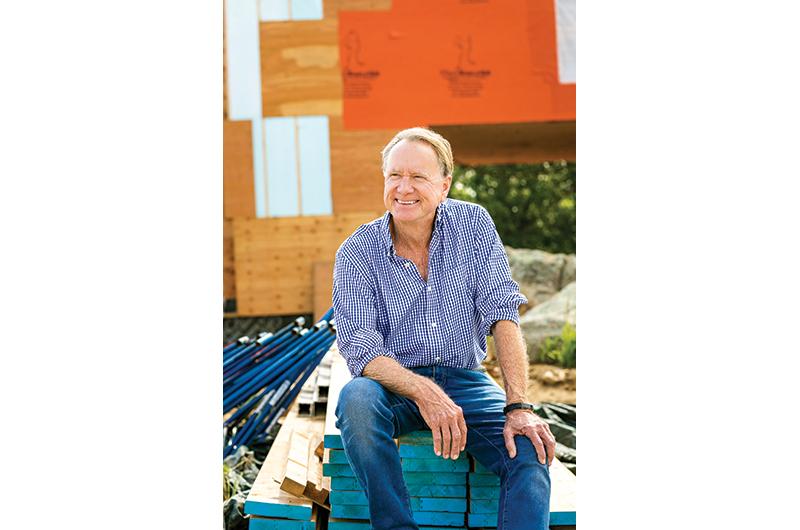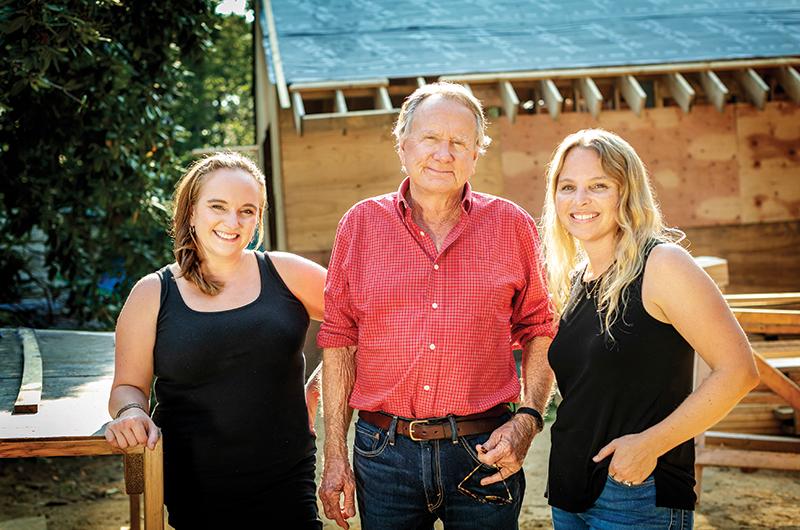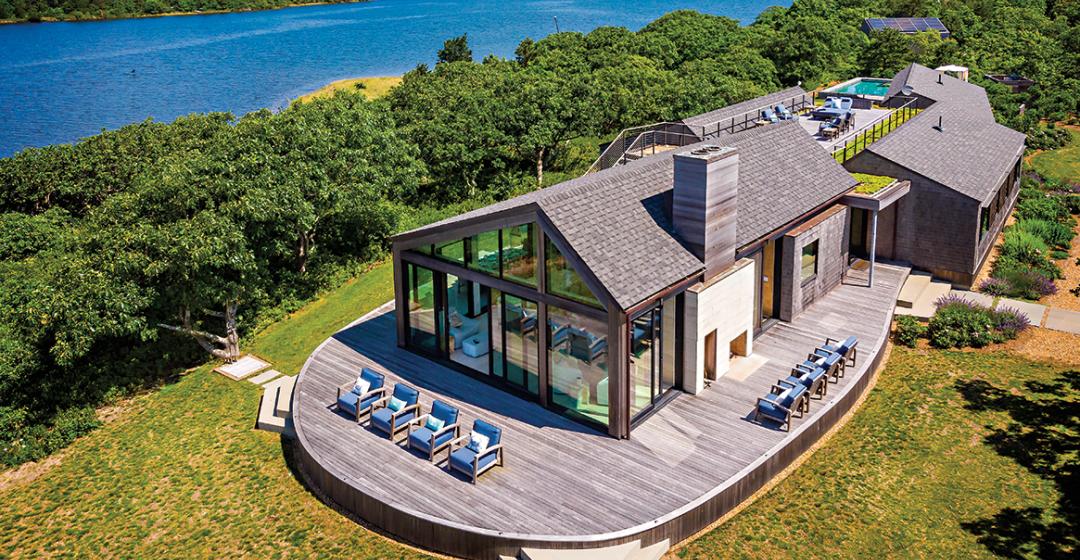When he first came to Martha’s Vineyard in the summer of 1965, Colin Whyte was an undergrad at Brown University with no inkling that he would found Martha’s Vineyard Construction Company, one of the premier builders on Martha’s Vineyard, which celebrates its fiftieth anniversary this year.
“I’d never been to Martha’s Vineyard,” he said via Skype from his winter home in Turks and Caicos. “A buddy of mine threw a map down and we decided the Vineyard looked like an interesting place to go.”
That summer he started a surfboard rental business on South Beach, located on the small swatch of dirt where the air pumps for Norton Point Beach now sit. “It was a pretty lean business. If there were a dozen cars, it was a busy day,” he said.
He also worked as a bartender at The Dunes in Katama, now the Winnetu Oceanside Resort, where local tradesmen could rub elbows with artist Chandler Moore and the novelist and playwright Thornton Wilder. “Thornton had a house in the Katama area,” Whyte said. “He would frequent the bar at the end of his day. We’d usually end up at The Lampost. C.B. Stark and her partner, Margery Meltzer, were waitresses there. It was a fun group. It didn’t take long to fill up a table.”
Over the next few years Whyte bounced between the Vineyard and Miami, with a detour to Washington, D.C., to intern for Florida Senator George Smathers, until he moved here for good in 1970.
“I came here with no job, no money, and no place to stay,” he said, grinning at the memory. “I knew a woman who had a little cabin in the woods on Lake Tashmoo. She let me live there for the summer if I moved the cabin down to her property in Tisbury in the fall. There was no water, no electricity, and no road. I had to go through the bushes to get to it. I stashed a flashlight in a tennis ball can so I could see my way home at night.
“At the end of the summer, Ross Gannon and I moved the cabin and lived there through the winter. We put sides on the trailer we used to move the cabin and started cleaning up building sites,” he recalled. “That was the beginning of Martha’s Vineyard Construction Company. Ross decided he wanted to be a boatbuilder and he went into business with Nat [Benjamin]. I guess things worked out pretty well for both of us.”

Whyte’s site clean-up business also became his trade school. “Somebody would need a roofer or a shingler at a job site, and I took every job I could,” he said. “It takes years to build up the skills you need. I was doing a lot of frame work when I decided to take the plunge. I built a few fairly simple spec houses out near Tashmoo, and I also worked on duplexes in Katama. That experience took a lot of the mystery out of the process. I built houses for Pat Gregory and Dick Goodell. I did a lot of work for teachers. I was the new, cheap guy on the block.”
Whyte credits Carlyle Cronig, long-time principal at Cronig’s Real Estate, for helping him grow Martha’s Vineyard Construction Company into one of the Island’s most sought after custom home builders. “We just liked each other,” Whyte said. “I would buy vacant lots, back when a vacant lot cost $2,500, and he’d loan me back his commission until we sold the house.”
With a dispassionate bearing and dry wit, Whyte comes across as the antithesis of the hard-charging, Type A construction business owner.
“Colin is enigmatic,” said senior project manager Mark Tonnesen, who has been with the company for twenty years. “He’s not the kind of owner-operator boss that comes around and gets in your face. There’s no micromanaging at all. He has a lot of trust in his people. He’s also incredibly loyal to subcontractors and vendors. Sometimes maybe too loyal.”
As his company’s reputation grew, Whyte’s client list went from local educators to notable people, such as Cyrus Vance, then the secretary of state under President Jimmy Carter.
“The Cyrus Vance house definitely raised the company profile. I was also doing a lot of work with Ben Moore, who was a great architect,” Whyte said. “I think the pivot point was a house on West Chop, owned by Sam and Diane Bodman. He became secretary of energy for George W. Bush. That house had a very high degree of difficulty. There were very intricate arts and crafts type finishes; they had a lot of antique cedar trees that would not be taken down and there was a lot of stonework. They were very particular owners, and they were very happy with the final product. But not everybody was happy about it.” Whyte recalled one neighbor referring to it as a “starter castle,” noting, “It doesn’t take much to draw fire.”
Whyte estimates his company has built or renovated more than 100 houses over the years. During that time, projects for Martha’s Vineyard Construction Company have grown in size and budget. Currently, the houses range from 2,500 to 16,000 square feet, with average budgets from $2 to $10 million. In several instances, clients have rehired Martha’s Vineyard Construction Company to renovate or replace the home the company built for them years ago.
Asked if he had moments of panic, thinking he’d bitten off more than he could chew, he joked, “That’s a recurring dream I had pretty much for the past fifty years. But I love the challenge and we have some very talented people who’ve been with us a long time. We always find a way to make it work.”

Often the challenge doesn’t make itself known until construction is underway. For up-Island projects, there is always a “boulder clause,” since the glacial moraine often contains massive geological surprises. “We had a project in Aquinnah where we discovered a thick layer of kaolin, a white clay, that had to be excavated and shipped off-Island before we could even get started,” Tonnesen recalled. “Then we had to cover the entire plot with calcium chloride, hay, and blankets to keep it from freezing solid during a polar vortex.”
Extensive measures can also be taken to preserve, and in some cases restore, the natural beauty of the land. “We had a 16,000-square-foot house up-Island that required a large envelope,” Tonnesen said. “We dug up thirty giant trees with fifteen-foot root balls and brought in a huge crane to move the trees and boulders.” They kept the trees alive for almost three years, “then planted them back on the property.”
Ingenuity can also be required to accommodate the desires of well-funded clients and their top-shelf architects. Case in point, a hilltop down-Island house with a long, steep staircase leading to the shoreline that the owner could no longer navigate. The answer turned out to be a funicular, of all things. “There’s a company that makes them and ships them all over the world,” said Tonnesen.
“We did it in the winter. It was cold; the wind was howling; it was a big challenge,” recalled senior project manager Drew Cathey. “We had a crane with two fifty-foot I-beams walk off a barge and onto the shoreline. It was quite a sight.”
The house stories of the rich and famous go on and on. One house had more than forty different profiles of custom-made exterior trim. “In another house we inlaid a beautiful multicolored compass rose in a wood floor,” Tonnesen recalled. “The owner, a really nice guy, asked if it was pointed toward true north or magnetic north, which I’d set it to using the compass on my phone. Turns out there was a [slight] difference…so we made the adjustment.”
A Squibnocket house they completed is powered by ten Tesla Powerwall batteries, which are charged by solar panels, enabling the home to be almost completely off the grid while minimizing the carbon footprint.
“We also get to work with some really cool materials, like sinker cypress from a swamp in Florida,” Tonnesen said. “The wood was probably 400 years old. It was dried out for a year and a half and sourced out to a mill shop.”
If you don’t know someone who owns a Martha’s Vineyard Construction Company home, you can get a taste of the craftsmanship with a trip to Offshore Ale Co. in Oak Bluffs, one of the most popular year-round restaurants on the Island.

“There’s a lot of details that people might miss,” Whyte said. “It was a very challenging project. It’s a tiny lot; it used to be a laundromat. The basement goes down fourteen feet, so we had to shore it up on two sides so the street didn’t cave in. The loft with the big tanks is poured concrete. The huge trusses that support the roof were built in the SBS parking lot and transported early on a Sunday morning.”
“Sometimes you look at a project and say, ‘I can’t believe we actually did that,’” Tonnesen said.
In recent years, Whyte, now seventy-six, has segued into a consulting role. His daughters, Hilary Moore and Alison Thompson – president and vice president, respectively – have taken over day-to-day operations, making Martha’s Vineyard Construction Company the only sizable construction company on the Island run by women.
Like Whyte’s own career as a builder, his daughters’ succession wasn’t part of a long-term plan. It came about organically. “It was an open question if it was going to work or not; it just evolved over time,” he said. “Both my daughters are very intelligent. Turns out they’re better at running the company than I was.”
He also credits his longtime staff for making the transition possible. “I’ve been fortunate to have people working for the company that stay for decades,” he said. “One guy has been here thirty years. Without them, this wouldn’t have happened.”
“The transition makes perfect sense,” Tonnesen said. “They both bring something very valuable to the table. Hilary comes from a more corporate environment. She’s very team oriented, and she has excellent communication skills. Our clientele can be pretty demanding, and her read on people can be very valuable. I think they both give us a more solid future. They’re both emotionally invested in the business and not someone just off the street.”
Both women grew up on the Island; both went to Wheaton College in Norton, Massachusetts; and both moved back to the Vineyard to raise a family. Thompson was living in Vermont, where she and her husband, Joe, had a successful business, Foam Insulation Technology (FIT). They opened a new FIT franchise on the Island, and she started doing the books for Martha’s Vineyard Construction Company in 2011. “I like staying behind the scenes,” Thompson said. “Hilary is more outgoing. She speaks her mind more than I do. I think it’s a good balance.”
Moore was grinding out a career in commercial real estate in Boston when she and her husband, Patrick, moved back to the Island in 2014. “I started out as [the office manager], worked up to operations manager, and now president,” she recalled, sitting in the Covid-quiet company office at the Airport Business Park.

“Getting into the construction business as a female was never something I aspired to do, but I wouldn’t change it for the world. It’s challenging at times to be a young female in this business. But contractors that think they can run over me find out pretty quickly that doesn’t happen.”
One hundred percent of Martha’s Vineyard Construction Company residential customers these days are from off-Island, and demand has skyrocketed as many of them have sought refuge from the pandemic.
“We’ve been slammed. It’s been our busiest year since I’ve been here,” Moore said. “It’s tricky – we don’t have enough subcontractors on the Island and prices for materials are crazy right now. We also have more supply delays at a time when customers want things done faster. But things are definitely getting better. During lockdown, I took Zoom calls next to my daughter’s bed because that’s where I got the best WiFi signal. I was doing performance evaluations as she was coming in and screaming at me to make slime with her.”
That third generation of Whyte’s family is already eyeing a role in the next fifty years. Moore’s five-year-old daughter, Avery, “sees that my sister and I can run this company and are succeeding in the business,” Moore said. “The other day she told me, ‘When I grow up I want to be a boss, just like you.’”




 1 comment
1 comment
Comments (1)